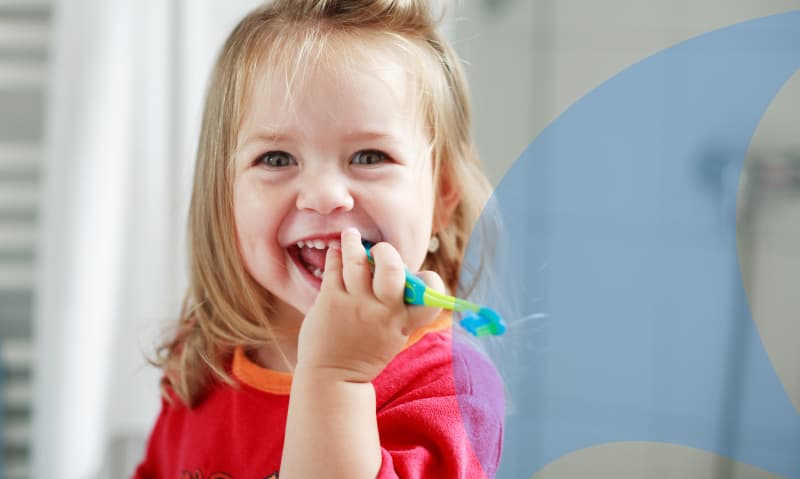6 Fun Ways to Get Your Kids to Brush and Floss

How to Teach Your Child to Get Excited About Oral Hygiene
Like taking a bath or eating their veggies, getting your kid to brush and floss on their own can sometimes feel like you’re pulling proverbial teeth. While you know to expect occasional resistance as a parent, having to convince your kids that their smile is worth caring for takes extra effort, which can be challenging or frustrating.
Know that we see and celebrate your efforts and that we have a few tricks up our sleeves to help instill the habit of brushing and flossing and reinforce good behavior. Guided by patience, positivity, creativity, and technology, here are 6 fun, practical pediatric dentistry tips to get your kid to brush and floss their teeth with enthusiasm.
1. Let your child choose their toothbrush.
Like picking a new toy, letting your child choose their toothbrush engages their sense of ownership, curiosity, and agency. And with so many designs and colors to choose from, your child has the opportunity to choose a toothbrush that matches their interests or personality.
To encourage your child to get excited about brushing their teeth, consider bringing them to the store with you to choose their toothbrush or letting them choose one online. If you are concerned that your child may choose a toothbrush that’s too hard or not appropriate for their age, narrow down their choices to a handful of options and let them choose from there.
2. Go electric.
Adding to the tip above, you may consider switching your child over to an electric toothbrush to get them brushing. Along with effectively removing more plaque from your tooth’s surface (21% more than a manual toothbrush, to be exact), electric toothbrushes also encourage better focus and gentler brushing.
3. Use technology to your advantage.
As a digital native, your kid has an especially unique relationship with technology that you can use to your advantage when teaching valuable habits, like brushing and flossing. When it comes to teaching your kid oral hygiene, there is indeed an app for that (and many of them are free).
While award-winning BrushDJ can play your child’s favorite tunes for two minutes, Brusheez Little Monster characters guide your child through two minutes of proper tooth brushing techniques. Does your child like The Wiggles or Disney? Try Brush Teeth with The Wiggles or Disney Magic Timer by Oral-B. If your child loves games and selfies, try Brush Up, a toothbrush training game with a trademark Selfie Assessment.
4. Add oral hygiene to imaginative play.
Make-believe play, like playing house or doctor, stimulates your child’s imagination and helps them process the world around them. To help your child integrate oral hygiene into their world and understanding, provide them with a play toothbrush they can use to pretend to brush their toys’ teeth. As you join them in playtime, you can share messages with their toys about how fun and important it is to keep smiles healthy with daily brushing and flossing.
5. Be a living example.
Observation is one of your child’s biggest resources for learning and developing habits and behaviors. From the dog’s bark to the soundtrack of Frozen, children often imitate the actions, words, songs, and sounds of the people, animals, and objects around them. This is how your child first learned to call you “mama” or “dada” and how they end up repeating words you’d rather they hadn’t heard you say!
With that, one of the best ways to enforce great oral hygiene habits is to make brushing and flossing teeth a visible family affair. Share your own enthusiasm about cleaning your teeth and let your child regularly observe you go through the whole process from start to finish. If you’re feeling a bit tired or stressed, you could even be honest with them about your experience by saying something like, “Mom/Dad is really tired tonight, though I know I’ll feel so much better after I take a few moments to brush and floss my teeth.”
6. Try positive reinforcement.
As an adult and a parent, you know that skipping out on brushing and flossing can lead to undesirable consequences that you want to spare your child from experiencing. Though explaining the seriousness of these consequences may seem logical or appealing, you may consider tapping into a positive reinforcement strategy instead.
Especially effective for school-aged children, positive reinforcement generally ignores undesirable behavior while focusing on and rewarding desirable behaviors. Neuroscientists have observed that children tend to respond more favorably to positive messages than negative feedback, as they don’t yet have the capacity to fully understand consequences and learn from their mistakes. To practice positive reinforcement, celebrate when your child brushes and flosses with a high five, sticker, a second book at bedtime, or another simple activity or treat that sparks your child’s interests and joy.
Getting your kids excited about their oral hygiene doesn’t have to be a hassle.
Though getting your kid to brush and floss regularly will take time and repetition, your conscious efforts are worth it and will ultimately help your child establish a routine that keeps their smile healthy for life. If you’re concerned about your child’s smile or oral health habits, Dr. Cooper and Dr. Day are here to help. For a smile checkup and to get personalized guidance from a dentist for kids, schedule your child’s next pediatric dentist visit today.